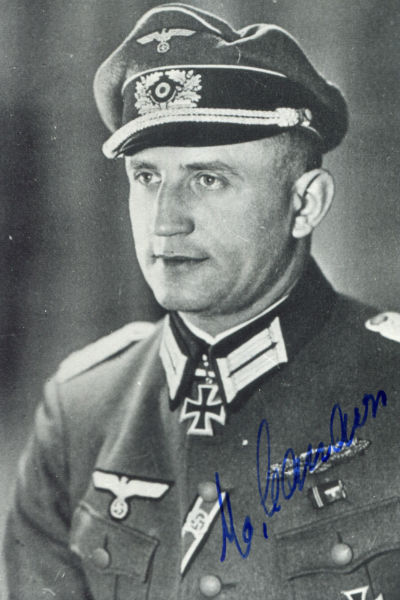Canders, Werner (Infanterie-Regiment 408)
- Date of birth:
- March 25th, 1914 (Berlin-Pankow, Brandenburg, Germany)
- Date of death:
- April 23rd, 1993 (Neumünster/Schleswick-Holstein, Germany)
- Nationality:
- German
Biography
Promotions:
1931 Soldat
1933 Obergrenadier
1934 Gefreiter
1934 Unteroffizier
1936 Feldwebel
1936 Oberfeldwebel
1940 OA
1940 Leutnant
1940 Oberleutnant
1942 Hauptmann
1944 Major
Career:
00.00.1931: entered the 14. Kompanie, Infanterie-Regiment 1
00.00.1932: 2. Kompanie, Infanterie-Regiment 1
00.00.1933: 16. (Unteroffizier-Lehr-) Kompanie, Infanterie-Regiment 1
00.08.1934-00.10.1934: Gruppenführer, Wach-Regiment, Berlin
00.09.1939: Zugführer, Infanterie-Regiment 1
01.02.1940: Offiziers-Anwärter, Zugführer, 5. Kompanie, Infanterie-Regiment 43
00.04.1940: Kompanie-Führer-Lehrgang
00.07.1942: Hauptmann, Chef, 2. Kompanie, Infanterie-Regiment 408, 121. Infanterie-Division
22.12.1942: Führer, III. Bataillon, Infanterie-Regiment 408, 121. Infanterie-Division
fightings South of Lake Ladoga, region Gaitolowo
00.04.1944: Major, Kommandeur, III. Bataillon, Grenadier-Regiment 408, 121. Infanterie-Division
08.06.1944: severely WIA and sent to a Lazarett
05.12.1944: Führer-Reserve des OKH
10.12.1944: Führer, Grenadier-Regiment 270, 93. Infanterie-Division
27.02.1945: Führer, Regimentskampfgruppe, 58. Infanterie-Division
00.03.1945: shipped from Pillau to Kopenhagen and then with a Lazarett-Zug to Plön in Holstein
00.05.1945: British POW
00.08.1945: Lagerleiter, Flüchtlingsdurchgangslagern Lübeck- Pöppendorf and Hamburg
11.01.1946: released
Do you have more information about this person? Inform us!
- Period:
- Second World War (1939-1945)
- Awarded on:
- October 2nd, 1939
- Period:
- Second World War (1939-1945)
- Awarded on:
- July 1st, 1940
- Period:
- Second World War (1939-1945)
- Awarded on:
- July 19th, 1940
- Period:
- Second World War (1939-1945)
- Awarded on:
- August 23rd, 1941
- Period:
- Second World War (1939-1945)
- Awarded on:
- October 27th, 1941
- Period:
- Second World War (1939-1945)
- Rank:
- Hauptmann (Captain)
- Unit:
- Chef, 2. Kompanie, Infanterie-Regiment 408, 121. Infanterie-Division
- Awarded on:
- July 28th, 1942
- Period:
- Second World War (1939-1945)
- Awarded on:
- July 29th, 1942
- Period:
- Second World War (1939-1945)
- Awarded on:
- March 17th, 1943
- Period:
- Second World War (1939-1945)
- Awarded on:
- April 28th, 1943
- Period:
- Second World War (1939-1945)
- Awarded on:
- August 14th, 1943
- Period:
- Second World War (1939-1945)
- Rank:
- Major
- Unit:
- Kommandeur, III. Bataillon, Grenadier-Regiment 408, 121. Infanterie-Division
- Awarded on:
- April 6th, 1944
“The Soul of the Resistance, Major Werner Canders, is Awarded the Knight’s Cross:
Mid-February 1944! Heavy defensive fighting rages in the northern sector of the eastern front. The enemy repeatedly attempts to disrupt the planned withdrawals of the German units and cut them off from their supply and connection roads. But more often than not these aims were frustrated by the steadfastness and the fighting spirit of the German soldier, which remains unbroken despite all the difficulties.
On the 17.02.1944 the Soviets launched a massive attempt to break through the positions of a Regiment belonging to the East Prussian 121. Infanterie-Division (the same unit recently mentioned in the OKW report). The Bataillon led by Major Canders fought in the midst of this bitter struggle. And here the right man found himself in the right place. The Wound Badge in Gold, Close Combat and Honour Roll Clasp, the German Cross in Gold - all of these high awards are the mark of the outstanding merit of this 30 year old Bataillon commander. And today, on the 17.02.1944, he was the soul of the resistance, passing on his unshakeable will to every one of his Grenadiers.
The enemy managed to achieve a penetration in the right Bataillon sector with the support of tanks. But Major Canders immediately adjusted to the new situation. Everything depended on keeping the Division’s primary communications road open. For this reason he swiftly resolved to refuse the front of his Bataillon against the now open flank in order to prevent a further Russian advance. However in the meantime they had already reached the Bataillon command post itself. Yet Major Canders did not think to give up his position. At the time he only had 9 Grenadiers available to him. But he knew that he could count on every one of them. He threw himself at the Soviets at their head, pushing them back in bitter close combat and forcing them out of the main battle line.
However he had barely finished doing so when he received word that the enemy had broken through with tanks and mounted infantry at the boundary with the left neighbour. He immediately rushed to the threatened location and started by bringing a Flak gun into position, and this destroyed 2 enemy tanks right off the bat. Major Canders utilized the confusion that this caused among the enemy to again launch a counterthrust with his Grenadiers, and with them he managed to eliminate this enemy penetration. The command measures by this Bataillon commander and his outstanding bravery thus brought about a desirable outcome.
The important road remained open, and the Division was able to carry out its planned movements in an orderly fashion.
Major Canders was awarded the Knight’s Cross to the Iron Cross for his bold and determined actions.
Major Canders was born in Berlin-Pankow. He is an active officer.”
- Period:
- Second World War (1939-1945)
- Awarded on:
- June 9th, 1944
Sources
- Photo 1: Russ Nummer
- Photo: http://www.ritterkreuztraeger.info/rk/c/C001Canders.pdf
- - THOMAS, FRANZ & WEGMANN, GüNTER, Die Ritterkreuzträger der Deutschen Wehrmacht 1939-1945, Biblio Verlag, Osnabrück, 1998.
- Die Ordensträger der Deutschen Wehrmacht (CD), VMD-Verlag GmbH, Osnabrück, 2002
- Fellgiebel W.P., Elite of the Third Reich, The recipients of the Knight's Cross of the Iron Cross 1939-1945: A Reference, Helion & Company Limited, Solihull, 2003, ISBN 1-874622-46-9
- Patzwall K., Scherzer V., Das Deutsche Kreuz 1941-1945, Geschichte und Inhaber Band II, Verlag Klaus D. Patzwall, Norderstedt, 2001, ISBN 3-931533-45-X
- Die Träger des Ritterkreuzes des Eisernen Kreuzes 1939-1945















